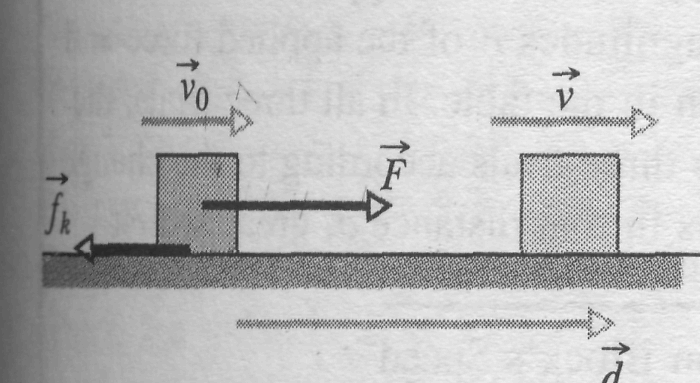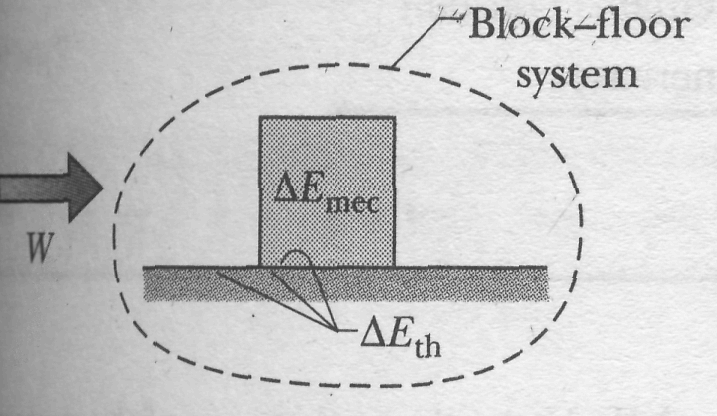
- •Mechanics Kinematics
- •1.2 Position and Displacement
- •Velocity and Coordinate by Integration
- •Dynamics of Translational Motion
- •The Concept of Forces
- •1.15. Rocket Propulsion (Example of Variable Mass Situation)
- •2 Path Independence of Conservative forces
- •Gravitational Potential Energy
- •Isolated System
- •Rotational motion
- •Angular Position
- •Angular Displacement
- •Angular Velocity
- •5.3.1. Uniform slender rod; axis perpendicular to length rod
- •5.3.2. Hollow or solid cylinder
- •5.3.3. Uniform sphere of radius , axis through center
Gravitational Potential Energy
We
first consider a particle with mass
moving
vertically along a
axis (the positive direction
is upward). As the particle moves from pointy to pointy, the
gravitational force
does
work on it. To find the corresponding change in the gravitational
potential energy of the particle-Earth system, we use Eq. 8-6 with
two changes: (1)
We integrate along the
axis
instead of the
axis,
because the gravitational force acts
vertically (2) We substitute
![]() for the force symbol
,
because
has the magnitude
and
is directed down the
axis.
We then have
for the force symbol
,
because
has the magnitude
and
is directed down the
axis.
We then have
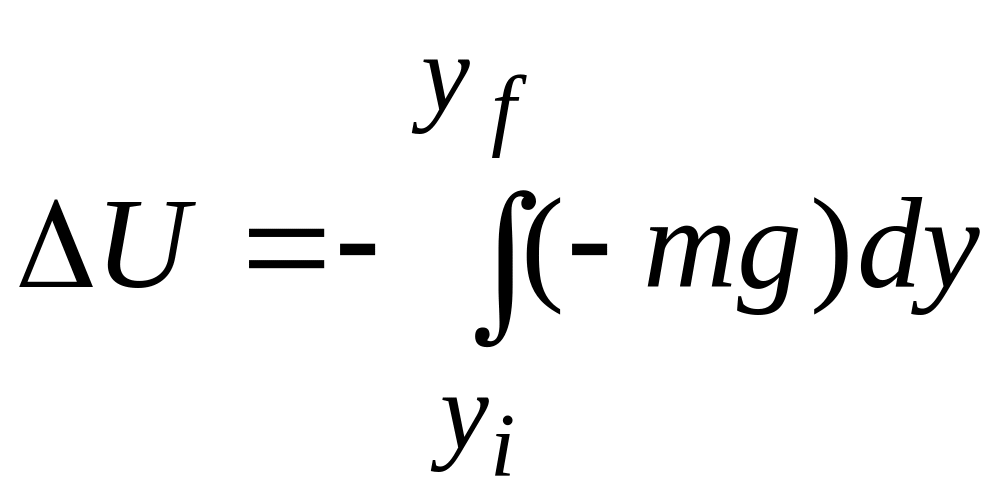
which yields
![]() (8-7)
(8-7)
Only changes in gravitational potential energy (or any other type of potential energy) are physically meaningful. However, to simplify a calculation or a discussion, we sometimes would like to say that a certain gravitational potential value U is associated with a certain particle-Earth system when the particle is at a certain height y. To do so, we rewrite Eq. 8-7 as
![]() .
(8-8)
.
(8-8)
Then we
take
![]() to
be the gravitational potential energy of the system when it is in
a
reference
configuration
in
which the particle is at a reference
point
.
Usually
we take
to
be the gravitational potential energy of the system when it is in
a
reference
configuration
in
which the particle is at a reference
point
.
Usually
we take
![]() and
and
![]() .
Doing this changes Eq. 8-8 to
.
Doing this changes Eq. 8-8 to
![]() (gravitational
potential energy). (8-9)
(gravitational
potential energy). (8-9)
This equation tells us:
► The
gravitational potential energy associated with a particle-Earth
system depends only on the vertical position
(or height) of the particle relative to the reference position
![]() ,
not on the horizontal position.
,
not on the horizontal position.
Elastic Potential Energy
We
next consider the block-spring system shown in Fig. 8-3, with the
block moving on
the end of a spring of spring constant
.
As
the block moves from point
to
point
,
the
spring force
does work on the block. To find the corresponding change
in the elastic potential energy of the block-spring system, we
substitute
![]() for
in Eq. 8-6. We then have
for
in Eq. 8-6. We then have

or![]() (8-10)
(8-10)
To
associate a potential energy value
with
the block at position x,
we
choose the reference configuration to be when the spring is at its
relaxed length and the block is at
![]() .
Then the elastic potential energy
is
0, and Eq. 8-10 becomes
.
Then the elastic potential energy
is
0, and Eq. 8-10 becomes
![]() which
gives us
which
gives us
![]() (elastic
potential energy). (8-11)
(elastic
potential energy). (8-11)
8-4 Conservation of Mechanical Energy
The
mechanical
energy
![]() of
a system is the sum of its potential energy
and
the
kinetic energy
of
the objects within it:
of
a system is the sum of its potential energy
and
the
kinetic energy
of
the objects within it:
![]()
In this section, we examine what happens to this mechanical energy when only conservative forces cause energy transfers within the system—that is, when factional and drag forces do not act on the objects in the system. Also, we shall assume that the system is isolated from its environment; that is, no external force from an object outside the system causes energy changes inside the system.
When a
conservative force does work W
on
an object within the system, it transfers energy between kinetic
energy К
of
the object and potential energy U
of
the system. From Eq. 7-10, the change
![]() in kinetic energy is
in kinetic energy is
![]() (8-13)
(8-13)
W and from Eq. 8-1, the change in potential energy is
Combining Eqs. 8-13 and 8-14, we find that
![]() (8-15)
(8-15)
In words, one of these energies increases exactly as much as the other decreases. We can rewrite Eq. 8-15 as
![]() 8-16
8-16
where the subscripts refer to two different instants and thus to two different arrangements of the objects in the system. Rearranging Eq. 8-16 yields
![]()
when the system is isolated and only conservative forces act on the objects in the system. In other words:
!► In an isolated system where only conservative forces cause energy changes, the kinetic energy and potential energy can change, but their sum, the mechanical energy of the system, cannot change.
This result is called the principle of conservation of mechanical energy. (Now you can see where conservative forces got their name.) With the aid of Eq. 8-15, we can write this principle in one more form, as
![]()
The principle of conservation of mechanical energy allows us to solve problems that would be quite difficult to solve using only Newton's laws:
► When the mechanical energy of a system is conserved, we can relate the sum of kinetic energy and potential energy at one instant to that at another instant without considering the intermediate motion and without finding the work done by the forces involved.
8-5 Reading a Potential Energy Curve
Once again we consider a particle that is part of a system in which a conservative force acts. This time suppose that the particle is constrained to move along an x axis while the conservative force does work on it. We can learn a lot about the motion of the particle from a plot of the system's potential energy U(x). However, before we discuss such plots, we need one more relationship.
Finding the Force Analytically
Equation
8-6 tells us how to find the change
in
potential energy between two points in a one-dimensional situation if
we know the force
.
Now
we want to go the other way; that is, we know the potential energy
function
![]() and want to find the force.
and want to find the force.
For
one-dimensional motion, the work
done
by a force that acts on a particle as the particle moves through a
distance
is
![]() .
We
can then write Eq. 8-1 as
.
We
can then write Eq. 8-1 as
![]() .
.
Solving for and passing to the differential limit yield
![]() (one-dimensional
motion). (8-20)
(one-dimensional
motion). (8-20)
-which is the relation we sought.
We can
check this result by putting
![]() ,
which
is the elastic potential energy function for a spring force. Equation
8-20 then yields, as expected,
,
which
is the elastic potential energy function for a spring force. Equation
8-20 then yields, as expected,
![]() ,
which
is Hooke's law. Similarly, we can substitute
,
which
is Hooke's law. Similarly, we can substitute
![]() ,
which
is the gravitational potential energy function for a particle-Earth
system, with a particle of mass m
at
height x
above
Earth's surface. Equation 8-20 then yields
,
which
is the gravitational potential energy function for a particle-Earth
system, with a particle of mass m
at
height x
above
Earth's surface. Equation 8-20 then yields
![]() ,
which
is the gravitational force on the particle.
,
which
is the gravitational force on the particle.
The Potential Energy Curve
Figure 8-10a is a plot of a potential energy function for a system in which a particle is in one-dimensional motion while a conservative force does work on it. We can easily find by (graphically) taking the slope of the curve at various points. (Equation 8-20 tells us that is negative the slope of the curve.) Figure S-lOb is a plot of found in this way.
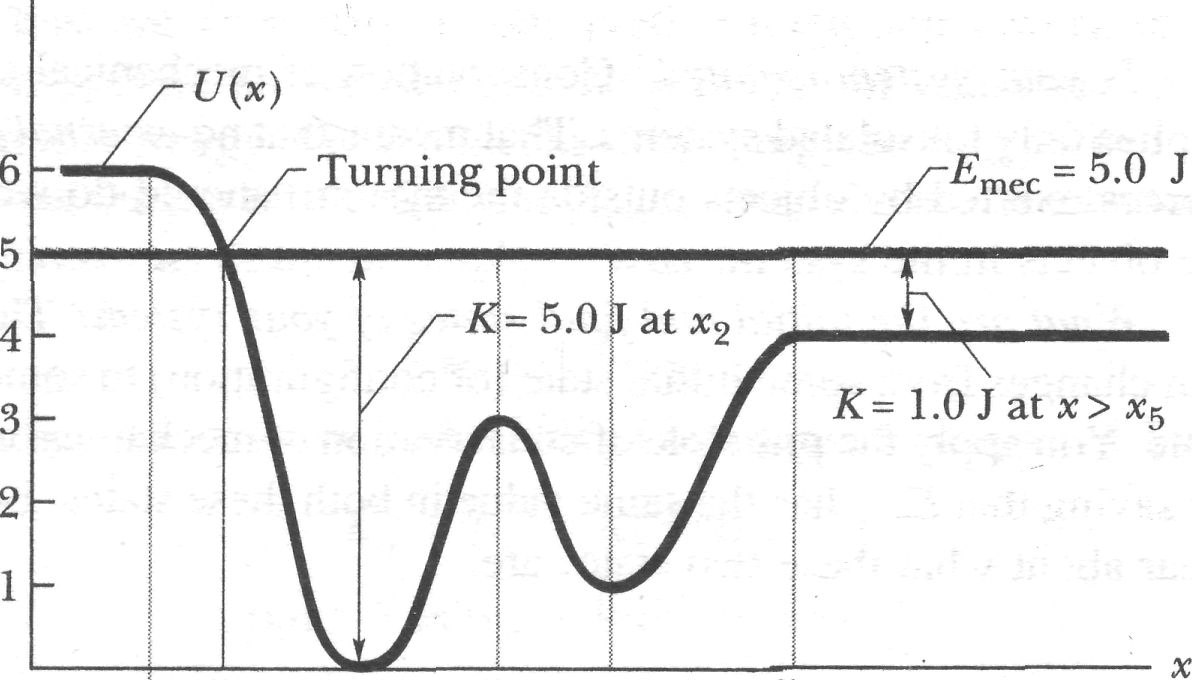
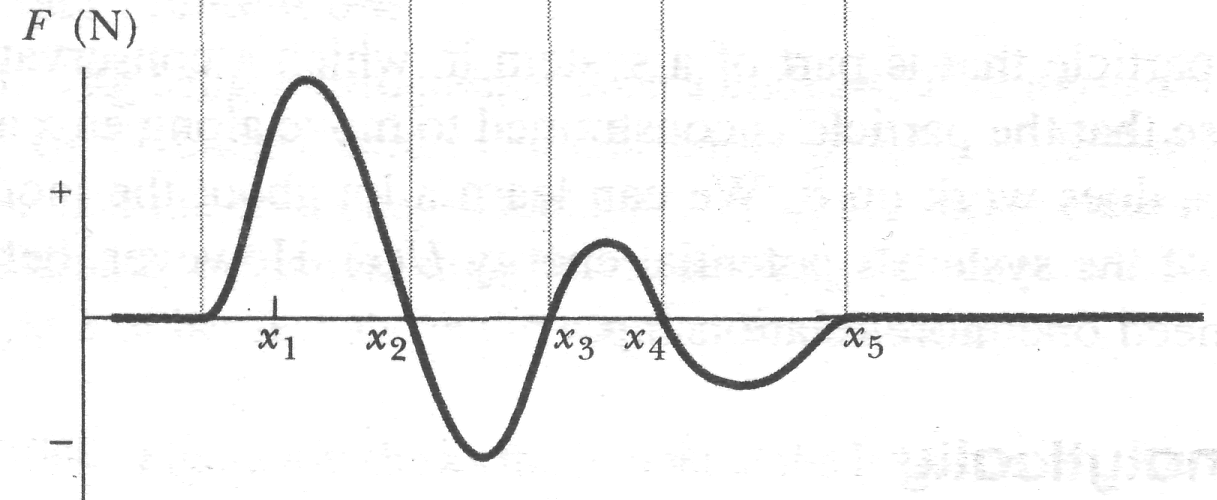

Turning Points
In the absence of a nonconservative force, the mechanical energy of the system has a constant value given by
![]() . (8-21)
. (8-21)
Here
![]() is
the kinetic
energy function of
the particle (this
gives
the kinetic energy as a function of the particle's location x).
We
may rewrite Eq. 8-21 as
is
the kinetic
energy function of
the particle (this
gives
the kinetic energy as a function of the particle's location x).
We
may rewrite Eq. 8-21 as
![]() (8-22)
(8-22)
Suppose that (which has a constant value, remember) happens to be 5.0 J. It would be represented in Fig. 8-10a by a horizontal line that runs through the value 5.0 J on the energy axis. (It is, in fact, shown there.)
Equation
8-22 tells us how to determine the kinetic energy
for
any location x
of
the particle: On the
curve, find U
for
that location x
and
then subtract U
from
For
example, if the particle is at any point to the right of
![]() ,
then
К
= 1.0
J. The value of К
is
greatest (5.0 J) when the particle is at x2,
and
least (0 J) when the particle is at xv
,
then
К
= 1.0
J. The value of К
is
greatest (5.0 J) when the particle is at x2,
and
least (0 J) when the particle is at xv
Since
can never be negative (because v2
is always positive), the particle can never
move to the left of
?
where
![]() is
negative. Instead, as the particle moves
toward
from.
x2,
К
decreases
(the particle slows) until К
=
0 at
(the
particle stops there).
is
negative. Instead, as the particle moves
toward
from.
x2,
К
decreases
(the particle slows) until К
=
0 at
(the
particle stops there).
Note that
when the particle reaches
,
the force on the particle, given by Eq. 8-20, is positive (because
the slope
![]() is
negative). This means that the particle does not remain at
but
instead begins to move to the right, opposite its earlier motion.
Hence
is
a turning
point,
a
place where
is
negative). This means that the particle does not remain at
but
instead begins to move to the right, opposite its earlier motion.
Hence
is
a turning
point,
a
place where
![]() (because
(because
![]() )
and
the particle changes direction. There is no turning point (where
)
on the right side of the graph. When the particle heads to the right,
it will continue indefinitely.
)
and
the particle changes direction. There is no turning point (where
)
on the right side of the graph. When the particle heads to the right,
it will continue indefinitely.
Equilibrium Points
Figure 8-10c shows three different values for superposed on the plot of the same potential energy function . Let us see how they would change the situation. If = 4.0 J (purple line), the turning point shifts from to a point between and x2. Also, at any point to the right of , the system's mechanical energy is equal to its potential energy; thus, the particle has no kinetic energy and (by Eq. 8-20) no force acts on it, and so it must be stationary. A particle at such a position is said to be in neutral equilibrium. (A marble placed on a horizontal tabletop is in that state.)
If
=
3.0 J (pink line), there are two turning points: One is between
and
,
and
the other is between
![]() and
.
In
addition,
and
.
In
addition,
![]() is a point at which
.
If the particle is located exactly there, the force on it is also
zero, and the particle remains stationary. However, if it is
displaced even slightly in either direction, a nonzero force pushes
it farther in the same direction, and the particle continues to move.
A particle at such a position is said to be in unstable
equilibrium.
(A
marble balanced on top of a bowling ball is an example.)
is a point at which
.
If the particle is located exactly there, the force on it is also
zero, and the particle remains stationary. However, if it is
displaced even slightly in either direction, a nonzero force pushes
it farther in the same direction, and the particle continues to move.
A particle at such a position is said to be in unstable
equilibrium.
(A
marble balanced on top of a bowling ball is an example.)
Next consider the particle's behavior if = 1.0 J (green line). If we place it at , it is stuck there. It cannot move left or right on its own because to do so would require a negative kinetic energy. If we push it slightly left or right, a restoring force appears that moves it back to : A particle at such a position is said to be in stable equilibrium. (A marble placed at the bottom of a hemispherical bowl is an example.) If we place the particle in the cuplike potential well centered at , it is between two turning points. It can still move somewhat, but only partway to or .
8-6 Work Done on a System by an External Force
In Chapter 7, we defined work as being energy transferred to or from an object by means of a force acting on the object. We can now extend that definition to an external force acting on a system of objects.
Work is energy transferred to or from a system by means of an external force acting on that system.
Figure 8-1 la represents positive work (a transfer of energy to a system), and Fig. 8-1 lb represents negative work (a transfer of energy from a system). When more than one force acts on a system, their net work is the energy transferred to or from the system.
These transfers are like transfers of money to and from a bank account. If a system consists of a single particle or particle-like object, as in Chapter 7, the work done on the system by a force can change only the kinetic energy of the system. The energy statement for such transfers is the work-kinetic energy theorem of Eq. 7-10 ( ); that is, a single particle has only one energy account, called kinetic energy. External forces can transfer energy into or out of that account. If a system is more complicated, however, an external force can change other forms of energy (such as potential energy); that is, a more complicated system can have multiple energy accounts.
Let us find energy statements for such systems by examining two basic situations, one that does not involve friction and one that does.
No Friction Involved
To compete in a bowling-ball hurling contest, you first squat and cup your hands under the ball on the floor. Then you rapidly straighten up while also pulling your hands up sharply, launching the ball upward at about face level. During your upward motion, your applied force on the ball obviously does work; that is, it is an external force that transfers energy, but to what system?
To answer, we check to see which energies change. There is a change in the ball's kinetic energy and, because the ball and Earth become more separated, there is a change in the gravitational potential energy of the ball-Earth system. To include both changes, we need to consider the ball-Earth system. Then your force is an external force doing work on that system, and the work is
![]() , (8-23)
, (8-23)
Or
![]() (work
done on system, no friction involved), (8-24)
(work
done on system, no friction involved), (8-24)
where
![]() is
the change in the mechanical energy of the system. These two
equations, which are represented in Fig. 8-12, are equivalent energy
statements for work done on a system by an external force when
friction is not involved.
is
the change in the mechanical energy of the system. These two
equations, which are represented in Fig. 8-12, are equivalent energy
statements for work done on a system by an external force when
friction is not involved.
Friction Involved
|
![]()
|
![]() .
.
Solving this equation for , substituting the result into Eq. 8-25, and rearranging then give us
![]()
because
![]() for
the block,
for
the block,
![]()
In a more general situation (say, one in which the block is moving up a ramp), there can be a change in potential energy. To include such a possible change, we generalize Eq. 8-27 by writing
![]() 8-28
8-28
By
experiment we find that the block and the portion of the floor along
which it slides become warmer as the block slides. As we shall
discuss in Chapter 19, the temperature of an object is related to the
object's thermal energy
![]() (the
energy associated with the random motion of the atoms and molecules
in the object). Here, the thermal energy of the block and floor
increase because (1) there is friction between them and (2) there is
sliding. Recall that friction is due to the cold-welding between two
surfaces. As the block slides over the floor, the sliding causes
repeated tearing and reforming of the welds between the block and the
floor, which makes the block and floor warmer. Thus, the sliding
increases their thermal energy
.
(the
energy associated with the random motion of the atoms and molecules
in the object). Here, the thermal energy of the block and floor
increase because (1) there is friction between them and (2) there is
sliding. Recall that friction is due to the cold-welding between two
surfaces. As the block slides over the floor, the sliding causes
repeated tearing and reforming of the welds between the block and the
floor, which makes the block and floor warmer. Thus, the sliding
increases their thermal energy
.
Through
experiment, we find that the increase
![]() in
thermal energy is equal to the product of the magnitudes
in
thermal energy is equal to the product of the magnitudes
![]() and
:
and
:
![]() (-increase
in thermal energy by sliding).
8-29
(-increase
in thermal energy by sliding).
8-29
Thus, we can rewrite Eq. 8-28 as
![]() 8-30
8-30
![]() is the work
done
by the external force
(the
energy transferred by the force), but on which system is the work
done (where are the energy transfers made)? To answer, we check to
see which energies change. The block's mechanical energy changes, and
the thermal energies of the block and floor also change. Therefore,
the work done by force F
is
done on the block-floor system. That work is
is the work
done
by the external force
(the
energy transferred by the force), but on which system is the work
done (where are the energy transfers made)? To answer, we check to
see which energies change. The block's mechanical energy changes, and
the thermal energies of the block and floor also change. Therefore,
the work done by force F
is
done on the block-floor system. That work is
![]() (8-31)
(8-31)
This equation, which is represented in Fig. 8-13b, is the energy statement for the work done on a system by an external force when friction is involved.
8-7 Conservation of Energy
We now have
discussed several situations in which energy is transferred to or
from objects and systems, much like money is transferred between
accounts. In each situation we assume that the energy that was
involved could always be accounted for;
that is, energy could not magically appear or disappear. In more
formal language, we
assumed (correctly) that energy obeys a law called the law
of conservation of energy,
which
is concerned with the total
energy
![]() of
a system. That total is the sum of the system's mechanical energy,
thermal energy, and any form of internal
energy in
addition to thermal energy. (We have not yet discussed other forms of
internal energy.) The law states that
of
a system. That total is the sum of the system's mechanical energy,
thermal energy, and any form of internal
energy in
addition to thermal energy. (We have not yet discussed other forms of
internal energy.) The law states that
> The total energy of a system can change only by amounts of energy that are transferred to or from the system.
The only type of energy transfer that we have considered is work done on a system. Thus, for us at this point, this law states that
![]()
where
![]() is any change in the mechanical energy of the system,
is any change in the mechanical energy of the system,
![]() is
any change in the thermal energy of the system, and
is
any change in the thermal energy of the system, and
![]() is any change in any other form of internal energy of the system.
Included in
are
changes
in kinetic energy and changes
in
potential energy (elastic, gravitational, or any other form we might
find).
is any change in any other form of internal energy of the system.
Included in
are
changes
in kinetic energy and changes
in
potential energy (elastic, gravitational, or any other form we might
find).
This law of conservation of energy is not something we have derived from basic physics principles. Rather, it is a law based on countless experiments. Scientists and engineers have never found an exception to it.

